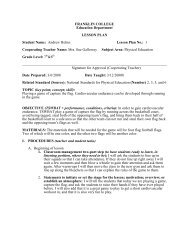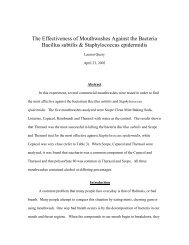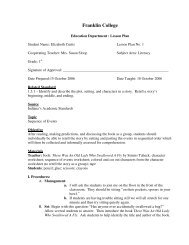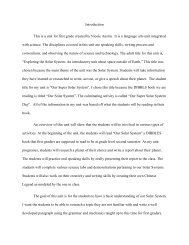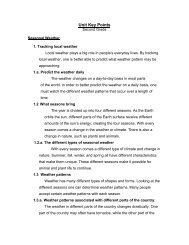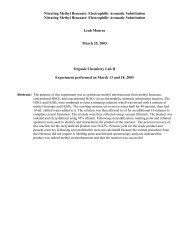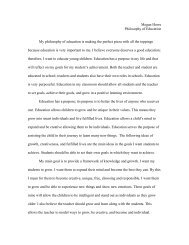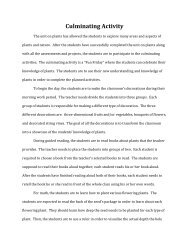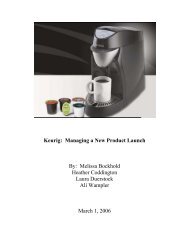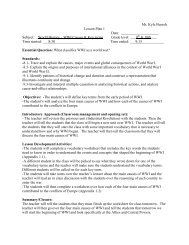The Diels-Alder Reaction of Anthracene with ... - Franklin College
The Diels-Alder Reaction of Anthracene with ... - Franklin College
The Diels-Alder Reaction of Anthracene with ... - Franklin College
You also want an ePaper? Increase the reach of your titles
YUMPU automatically turns print PDFs into web optimized ePapers that Google loves.
SYNT 717: <strong>The</strong> <strong>Diels</strong>-<strong>Alder</strong> <strong>Reaction</strong> <strong>of</strong> <strong>Anthracene</strong> <strong>with</strong> Maleic<br />
Anhydride<br />
Linsey J. Page<br />
February 19 th – February 21 st , 2002<br />
Organic Chemistry Laboratory II<br />
Abstract:<br />
This experiment allows one to perform a diels-alder reaction using anthracene and<br />
maleic anhydride. We also see different ways to determine the purity <strong>of</strong> products gained<br />
from a diels-alder reaction. <strong>The</strong> melting point process allows us to compare the boiling<br />
points <strong>of</strong> our product <strong>with</strong> the melting point <strong>of</strong> another molecule to determine how<br />
closely it relates to it. For example my recrystallization showed that my product was a<br />
pure 9,10-dihydroanthracene-9,10-A,B-succinic acid. <strong>The</strong> DRIFT infrared spectroscopy<br />
allowed us to look at a spectrum for 9,10-dihydroanthracene-9,10,-A,B-siccinic acid and<br />
compare the peaks <strong>with</strong> our own products.
SYNT 717: <strong>The</strong> <strong>Diels</strong>-<strong>Alder</strong> <strong>Reaction</strong> <strong>of</strong> <strong>Anthracene</strong> <strong>with</strong> Maleic Anhydride<br />
Introduction:<br />
During this experiment students used the <strong>Diels</strong>-<strong>Alder</strong> reactions <strong>of</strong> <strong>Anthracene</strong> and<br />
Maleic Anhydride to form a bridge polycyclic anhydride. <strong>The</strong> product gained from this<br />
reaction was then recrystallized. Afterwards, it was characterized by taking the melting<br />
points and an Infrared Spectroscopy using the DRIFT method.<br />
Materials Used<br />
• 150-ml beaker<br />
• boiling chip<br />
• 2 Erlenmeyer flasks, 10-ml<br />
• 25-ml filter flask <strong>with</strong> vacuum<br />
tubing<br />
• filter paper<br />
• Hirsch Funnel<br />
• 2 melting point capillary tubes<br />
• microspatula<br />
• 1-ml pipets<br />
• sand bath<br />
• support stand<br />
• thermometer<br />
• 13 x 100-mm test tube<br />
Reagents and Products Properties:<br />
Substance Quantity used Molar mass Melting Point<br />
(g/mol)<br />
( o Boiling Point<br />
C)<br />
( o Density<br />
C)<br />
anthracene<br />
9,10dihydroanthrac<br />
106 mg 178.23 216-218 340 ----ene-9,10,A,B,succinic<br />
anhydride<br />
----- 276.29 262-264 ----- -----<br />
Maleic<br />
anhydride<br />
58-mg 98.06 54-56 200 1310 kg/m 3<br />
Potassium<br />
bromide<br />
100 mg 119.1 730 ----- 2.753 g/cc<br />
xylene 6-ml 106.17 13.4 - -47* 137-144 -----<br />
* <strong>The</strong> melting points differ between para, meta, and ortho configuration. (13.4-para, -25-ortho, -47-meta)
Procedure:<br />
Place a 10x100-mm reaction tube into a small flask. Place them both onto a scale<br />
and tare them. Weigh out approximately 100-g <strong>of</strong> anthracene and approximately 55-g <strong>of</strong><br />
maleic acid. Place both into the 10x100-mm reaction tube. <strong>The</strong>n add 1.0-ml <strong>of</strong> xylene to<br />
the reaction tube along <strong>with</strong> the anthracene and maleic acid. Place a boiling chip into the<br />
solution. Place the reaction tube onto a support stand and wrap a cold kim wipe around<br />
the top <strong>of</strong> the tube. Place it into a heat bath that is around 200 o C and reflux the solution<br />
for 30 minutes.<br />
After 30 minutes, remove the solution from the heat and allow it to cool to room<br />
temperature. <strong>The</strong>n place it into an ice bath for five minutes. While your original solution<br />
is in the ice bath, measure out 2-ml <strong>of</strong> xylene into another tube and place it in the ice<br />
bath. While these tubes are in an ice bath, set up a filtration apparatus. Place a Hirsch<br />
funnel into a 25-ml filter flask and add a vacuum tube that runs from the flask to the<br />
vacuum. Once the original solution has been in the ice bath for five minutes run it<br />
through this filtration apparatus. Rinse it <strong>with</strong> 1-ml <strong>of</strong> xylene and allow them to dry.<br />
Weigh the crystals collected and set aside a portion for melting point analysis later.<br />
Place the crystals from part one and place it into a 10-ml flask. Add 1-2-ml <strong>of</strong><br />
xylene to the crystals. Heat this solution in the flask, and allow it to boil. Once it has<br />
boiled for a while remove it from the heat, allow it to cool, and place it into an ice bath.<br />
Collect the new crystals by the same vacuum filtration method mentioned above. Rinse<br />
the crystals <strong>with</strong> 1-ml <strong>of</strong> xylene. Allow the crystals to dry, overnight if possible.<br />
Take the crystals that were formed in the first part <strong>of</strong> the experiment and the<br />
recrystallized crystals from the second part <strong>of</strong> the experiment and place a small amount <strong>of</strong><br />
them into two separate melting point capillary tubes. Place the tubes into the melting
For this experiment I used 106-mg <strong>of</strong> anthracene and 58-mg <strong>of</strong> maleic anhydride.<br />
<strong>The</strong> theoretical yields for each <strong>of</strong> these only differed slightly. <strong>Anthracene</strong> was .1643g<br />
and the maleic acid was .1634g. Maleic acid is the limiting reagent in this experiment.<br />
In the first crystallization I recovered .128g <strong>with</strong> a melting point <strong>of</strong> 259-262 o C. This<br />
boiling point showed that there are slight impurities in the final product. <strong>The</strong> percent<br />
yield is 78.34%.<br />
For the recrystallization, I recovered .106g <strong>of</strong> product. <strong>The</strong> percent yield for this<br />
was 64.87%. It had a boiling point <strong>of</strong> 260-263 o C. This is very similar to the melting<br />
point <strong>of</strong> 9,10-dihydroanthracene-9,10-A,B-succinic acid which is 262-264 o C. This<br />
showed that my final product was very pure. <strong>The</strong> loss in percent yield was because we<br />
had to remove part <strong>of</strong> the product in the first part <strong>of</strong> the experiment. A small amount was<br />
saved from the first crystallization in order to do a melting point on it. Overall, I had a<br />
fairly good percent yield knowing that I lost some <strong>of</strong> it to the removal from the first<br />
crystallization. <strong>The</strong> only other things that might have effected the percent yield was loss<br />
<strong>of</strong> solution to the environment during reflux.<br />
Reference:<br />
Wade, L.G., Jr. SYNT 717: <strong>The</strong> <strong>Diels</strong>-<strong>Alder</strong> <strong>Reaction</strong> <strong>of</strong> <strong>Anthracene</strong> <strong>with</strong> Maleic<br />
Anhydride 33-43




